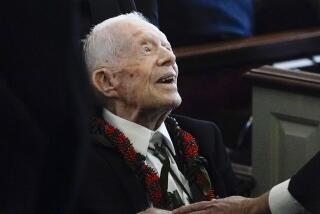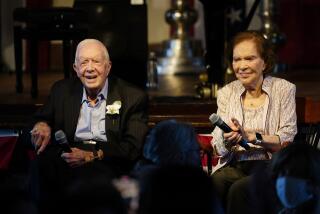Carter’s Hometown Goes Back Into Its Shell
PLAINS, Ga. — The sign in Hugh Carter’s antiques and souvenir shop reads: “President Jimmy Carter Will Teach the Sunday School Lesson This Week at Maranatha Baptist Church. You Are Invited.”
“Jimmy teaches the adult Sunday School class every Sunday he’s in town. He tells me if he is going to be here and if he is I put this sign in the window,” said Hugh Carter, 68, the former President’s first cousin.
When the 39th President shows up at the church in this small town of 683--usually once or twice a month--about 100 attend his class. Half are regular church-goers and the others are visitors who want to meet and hear the former President.
“Jimmy visits with the people after church,” noted Boze Godwin, 45, the local druggist and mayor of Plains. “We see Rosalynn and Jimmy Carter a lot around town, riding their bicycles and jogging.”
When Carter was in the White House from 1977-81, Plains and its one-block main street were packed with-out-of-towners.
“Every place boomed--souvenir shops, cafes, the Peanut Museum. You can’t imagine the number of people here, sometimes as many as 30,000 on one day,” Hugh Carter recalled.
“Something exciting was happening all the time. Long lines of cars would be waiting to buy gas from Billy. Big-time reporters like Tom Brokaw and Sam Donaldson were in and out. When Jimmy would come here the place would go crazy.”
Now most of the stores on Main Street are vacant, the Peanut Museum is closed and there is only a trickle of out-of-towners.
Even a faded sign proclaiming “Plains, Georgia home of Jimmy Carter,” has been altered. Since Sept. 25, the day Billy Carter died, the sign has been covered with a sheet bearing two red hearts and a scrawled message from his children: “PLAINS, GEORGIA HOME OF BILLY CARTER. WE LOVE YOU.”
After leaving the White House, the Carters returned to Plains and the modest one-story brick ranch-style home they built in 1962.
In “Everything to Gain: Making the Most of the Rest of Your Life,” published last year by Random House, Jimmy Carter wrote: “We came home from the U.S. Navy when my father died, stayed here after losing the first gubernatorial race, and came back after we had won and spent four years in the mansion in Atlanta. We returned again to Plains and our 25-year-old home, the only one we’ve ever owned when we left the White House.”
Both Jimmy Carter and Rosalynn Smith were born in Plains. Their ancestors came here in the 1700s. The President’s father, James Earl Carter, was a peanut farmer and storekeeper; his mother, “Miss Lillian,” a registered nurse. Rosalynn Carter’s father, Edgar Smith, was the town’s school bus driver and auto mechanic.
Plains, Carter wrote in his book, is “Without hustle and bustle, where one can amble among neighbors who would have been just as friendly to us if we had never done anything other than grow peanuts for a living. We enjoy being among our people.”
“We love our house. We find it satisfying not only to do a lot of our own yard work and most of the repairs and renovations in our home, but also to design and build cabinets and furniture.”
Last December, Congress passed a bill establishing the Jimmy Carter National Historic Site and Preservation District and appropriated $3.5 million for that purpose. The site was established to interpret the life and presidency of Jimmy Carter and to preserve the character and history of Plains, most of which is encompassed by the preservation district.
The site’s visitors center is in the Old Seaboard Railroad Depot, headquarters for Carter’s presidential campaign. The depot is filled with photographs and memorabilia detailing Jimmy Carter’s youth, his marriage to Rosalynn Smith in 1946, their family, his peanut business and years as governor and President.
Plains High School, built in 1921 and vacant since 1979, is scheduled to be restored. “The classrooms will be typical of when Jimmy was there from 1937 to 1941. We will show films about Jimmy Carter in the school auditorium,” said John N. Tucker, 40, superintendent of the historic site.
Plans also call for the purchase and restoration of the President’s boyhood farm home where he lived during the 1930s. The Carters’ current home will become part of the National Park Service’s historic site upon their death.
For the past six years, Jimmy Carter has been a professor of history, political science and international relations at Emory, a relatively small university in Atlanta. The former President and his wife have written five books and have been building houses for the poor with the Habitat for Humanity Project since leaving the White House.
Though Plains is their home, “Mr. and Mrs. Carter are away more than they are here,” explained Melissa Montgomery, Carter’s press secretary. When in Atlanta, the Carters stay at an apartment at the Carter Presidential Center, she explained.
Alma Chapman, 38, an eighth-grade teacher at Americus, near Plains, said: “Rosalynn and Jimmy Carter are two of the friendliest people you would ever want to meet. They know everybody in town. The other day I was out raking leaves and here comes Mr. Carter on his bike. ‘Come over to my place and help me rake my leaves,’ he called out laughing as he rode by.”
At Hugh Carter’s shop--the same store his father Alton opened in 1909--visitors can buy fried and green broiled peanuts, pecans, T-shirts, post cards and even empty Billy Beer cans. Also available are copies of the Carters’ five books, each autographed by the President.
“Didn’t anything wake this town up like Jimmy getting to be President,” said Hugh Carter, who served as a Georgia state senator for 14 years.
Also of interest to visitors is the public housing project where Jimmy and Rosalynn Carter and their two sons, John and James Earl III, shared an apartment in 1953-54. Daughter Amy was born in 1967.
Elizabeth Tice, 86, lives there now. She pays $101 a month. The Carters paid $40. A plaque next to Tice’s front door reads: “Not having any assured income, we applied for and were assigned an apartment in the new housing project in Plains.” --Jimmy Carter, 39th President.
“I moved in before he became President,” Tice said. I had my picture taken with Jimmy Carter when the plaque was dedicated two years ago. Mr. and Mrs. Carter were both here at the time. I go to the Methodist Church with Rosalynn’s mother, Mrs. Allie Smith.”
Across from the Plains Railroad Depot is the gas station that Billy Carter owned and operated from 1972 to 1981. He sold it to his friend Bobby Salter, 49, who now runs it. “Billy was down here everyday,” Salter said. “We sure miss Billy.”
He was buried at the Plains Lebanon Cemetery next to the graves of James Earl and Lillian Carter.
More to Read
Sign up for The Wild
We’ll help you find the best places to hike, bike and run, as well as the perfect silent spots for meditation and yoga.
You may occasionally receive promotional content from the Los Angeles Times.






